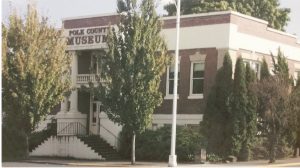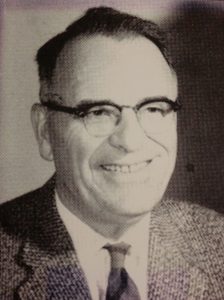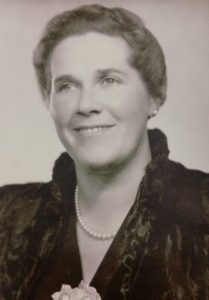The Creation of the Polk County Historical Society
A group met December 18, 1958, to formulate a Polk County Historical Society. Mrs. Clares Powell invited fourteen ladies to her home on January 1, 1959, to explore interest in organizing a society.
Iris Powell was appointed temporary chairman and Emma Henkle was the temporary secretary. On January 21, 1959, a permanent organization was formed. A constitution was adopted and officers elected. Those elected were: Francis B. Haines, President; Mrs. Delwen Reinemer, Vice President; Mrs. Leland Prather, Secretary; Mrs. O.B. Lyday, Treasurer.
In an April 23, 1959, news article, Dr. Haines stated there were ninety-five signed as charter members.
Meanwhile, the Polk County Museum Commission had dreams of sharing their love of all things historical with residents and visitors alike, long before there was any building to call home. When the Commission disbanded in 1989, the Museum Association continued fundraising efforts while reorganizing into a non-profit organization. Until a permanent building could be realized, the Association became temporary tenants in the 1912 Carnegie Library Building provided by the City of Dallas. On February 16, 1991, the Polk County Museum opened for business.

The Museum Association had been collecting treasures, both donated and on loan, for years. These treasures were now available to be seen and shared with the public, no longer hidden in attics, garages and sheds. The artifacts and documents collected reflected the diversity of cultures and people of the Polk County area. Opening ceremonies included talks by local collectors and historians, performances by local musicians and songs sung by Grande Ronde elders to the beating of a skin drum.
Polk County continued to support museum construction efforts by providing a 99-year lease on the southwest corner of the Fairgrounds, and the Polk County Commissioners came through with $2000 to create a permanent home for the historical artifacts of the Polk County area.
The Museum Association merged with the Polk County Historical Society in 1995, continuing to dream of a new, larger facility. Their tireless efforts proved that dreams really do come true. In the fall of 1999, the current 80x100-foot facility located on Highway 99W on the Polk County Fairgrounds, opened its doors to the public. In 1974, PCHS was bequeathed the Harrison Brunk pioneer farm site located at Brunk’s Corner, the junction of Highways 51 and 22.
The story has just begun. The dedicated members of the Polk County Historical Society, local City and County Governments and the descendants of Polk County history will continue their efforts to bring history to life for those who wish to learn from the past.

Francis B. Haines

Iris Powell
The Polk County Historical Society Today
The Polk County Historical Society is a public-benefit, non-profit corporation managed by a Board of Directors consisting of the President, the Vice-President, the Secretary, the Treasurer, and nine Directors. Board members are elected at the Annual Membership Meeting held each January. The volunteer Board of Directors meets monthly to implement the pronouncements comprising the PCHS Mission Statement. Learn more about the Board of Directors by visiting the Board Members Page.
The Polk County Historical Society has grown to include more than 300 members and continues to grow. To learn more about becoming a member of the Polk County Historical Society, visit our Membership Page or Contact Us.
Our Mission
The purpose for which the Polk County Historical Society is organized shall be:
- to encourage the study, knowledge, and understanding of the history of Polk County, Oregon;
- to collect, preserve, exhibit and interpret objects and publish information relating to the history of Polk County;
- to acquire, exhibit, and interpret the material culture of Polk County;
- to operate and maintain a historical museum or museums in Polk County.
The Polk County Historical Society invites you to visit the Polk County Museum. Our 14,000-square-foot facility is located about eight miles west of Salem in the middle of the Willamette Valley, near the junction of Highway 99 W and Highway 22 W. This site along Highway 99W is not far from the old Southern Route, a well-used immigration trail that stretched from Fort Vancouver all the way to California. Polk County, named for President James K. Polk, was established in 1845 and has a rich early pioneer heritage.
The Museum is a non-profit organization that is totally staffed by volunteers, both amateur and professional. It is also a research facility with a fine archival collection. Many artifacts--physical, pictorial, and written--from the eras of 1842 to 1960 are on display in the Museum and at the Historic Brunk House, just a couple miles east. A large number of the original pioneer families still have descendants in the area who have graciously shared their family treasures and enriched our inventory.
The Museum regularly hosts educational programs on local history. Its annual Family Day in the spring showcases special activities and events for the entire family, such as Civil War reenactments, demonstrations of pioneer skills, and children's activities, all geared to give you a taste of life "back when."
Historic Brunk Farmstead, also owned and operated by the Polk County Historical Society, is an 1861 two-story farm home featuring furnishings of that era. In addition there are outbuildings, gardens, and orchards where you can explore what it was like to live on a working farm of the time.